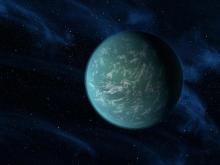Astronomers have spent a lifetime chasing the holy grail according to Michio Kaku, the author of the New York Times best-selling book Physics of the Future. On December 5, 2011, the Kepler space mission discovered an extrasolar planet that has been referred to as Earth’s twin in the media. This planet is also in the Goldilocks zone as it orbits its host star.
Kepler-22b is the name of the planet and it is yet to be determined whether it is a rocky planet or a water world. Moreover, it may be almost exactly like the Earth but there has to be some more estimations that have to be made regarding certain things like cloud cover before astronomers can arrive at this conclusion. NASA has already found that this planet is two and half times the size of the Earth and has an orbital period of about 290 days and is closer to its star than Earth is to our sun.
This finding is a breakthrough because it confirms the idea that there are extrasolar planets similar in size to the Earth that orbit their host stars in the habitable zone. This pretty much means that the chances of extraterrestrial life go up greatly. Another observation of the Kepler-22 system that is very interesting is the fact that the star is similar to our sun.
Since Kepler-22b is a shorter distance from its star and there is a lower stellar luminosity detected, the planet could have a moderate surface temperature. In the presence of an atmosphere and one that provides a greenhouse effect comparable to how it is on the Earth, scientists have estimated that the planet would have an average surface temperature of 72 °F which is actually very nice!
Sometimes I wish I was born a thousand years later or even ten thousand years later because I would love to see the advances made by mankind!
